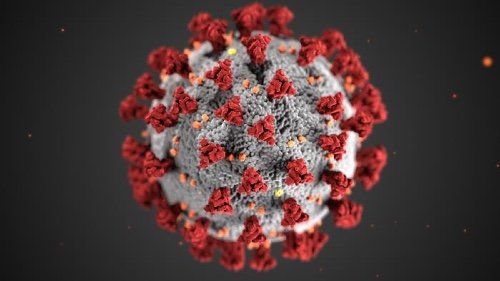Differentiating COVID-19 from Other Viruses in Kids
COVID-19 and other viral infections have unique imaging characteristics that can help with diagnosis, experts say.

COVID-19 is the latest in a string of respiratory viruses that have reached epidemic status in the last 20 years, and, fortunately, its impact on pediatric patients has been milder than disease experienced by adults. But, having immature lungs and immune systems still puts them at risk, making it critical that you’re able to distinguish between this virus and others that share similar clinical symptoms.
To help you pinpoint the radiologic findings that can be used to accurately identify a viral infection, researchers led by radiologist Alexandra M. Foust, M.D., from Boston Children’s Hospital and Harvard Medical School, published an article in the American Journal of Roentgenology that lays out how the imaging characteristics of not only COVID-19, but also the viruses that cause SARS, MERS, H1N1, as well as the traits of EVALI, the newly identified lung disease associated with vaping, manifest in children.
“A clear understanding of the imaging manifestations of these pediatric lung disorders is essential so that the radiologist can make a timely and accurate diagnosis,” wrote lead study author Alexandra M. Foust, M.D., from the department of radiology at Boston Children’s Hospital and Harvard Medical School. “Although there are some overlapping imaging features of these disorders, careful evaluation … can allow the radiologist to offer a narrower differential diagnosis in pediatric patients, leading to optimal patient care.”
The researchers outlined the characteristic imaging findings on chest X-ray and chest CT in this patient group, as well as what you need to know most about how these viruses show up on scans.
COVID-19
Chest X-ray You might see a normal scan. But, you could also see:
- patchy, bilateral, peripheral lower lung zone-predominant consolidation
- ground-glass opacities
Chest CT These scan typically show:
- Bilateral multifocal ground-glass opacitites with or without consolidation, peripheral and subpleural distribution (often extending to the pleural surface), possible halo sign
- Central distribution, pleural effusion, and lymphadenopathy are rare, prompting consideration of a different diagnosis
Helpful features COVID-19 frequently presents with bilateral multifocal ground-glass opacity, often with associated consolidation, in a peripheral and subpleural distribution. You would also see a halo sign. However, central distribution, pleural effusion, and lymphadenopathy are rare, and if you see them, it should lead you to a broadened differential diagnosis.
EVALI
Chest X-ray These scans include:
- bilateral, multifocal ground-glass opacities, consolidation, or both
- symmetric
- Lower-lung zones
- Possible subpleural sparing
Chest CT With these scans, you’ll likely see:
- Bilateral symmetric ground-glass opacities with or without consolidation
- Subpleural sparing
- Mild lower-lobe predominance
- Possible centrilobular nodules
- Possible atoll sign
Helpful findings: EVALI most commonly presents with multifocal, bilateral symmetric ground-glass opacities, consolidation, or both. Scans frequently show subpleural sparing. Additionally, the atoll sign may be seen, and when it is, it can help narrow down the differential diagnosis.
SARS
Chest X-ray The findings are often normal, but you could see:
- Patchy, unilateral opacities, especially during the early stage
- Lower-lung zone predominance
- Findings are multifocal opacities in approximately one-third of cases
Chest CT These scans will include:
- Unifocal or multifocal ground-glass opacities, consolidation, or both
- Early stage might be unilateral or bilateral
- Peripheral or combined peripheral and central distribution
- Mid and lower lung zones
Helpful findings SARS often presents initially with unifocal ground-glass opacities, consolidation, or both in the lower lung zone in a peripheral or combined peripheral or central distribution.
MERS
Chest X-ray Scans of this viral infection show:
- Unifocal ground-glass opacities in mid-and-lower lung zones
- Can progress to multifocal, bilateral, or both
- Fine interstitial reticular pattern
- Pneumothorax or pleural effusion (more common in fatal cases)
Chest CT The findings here include:
- Bilateral ground-glass opacities with or without consolidation
- Peripheral and lower-lung zone distribution
- Pleural effusion (more common in fatal cases)
Helpful findings MERS can initially present with unifocal ground-glass opacities, consolidation, or both in a peripheral and lower lung zone distribution. You could also see pleural effusion or pneumothorax, and this suggests a much more severe clinical course for the patient.
H1N1
Chest X-ray These scans are often normal, but there are differences between mild and moderate-to-severe cases:
- Mild: Bilateral hyperinflation and prominent peribronchial markings
- Moderate-to-severe: One or more areas of ground-glass opacities, consolidation, or both in bilateral distribution
Chest CT These findings include:
- Bronchovascular thickening
- Bilateral, multifocal central lung-predominant ground-glass opacity, consolidation, or both
- Possible pneumomediastinum
Helpful findings With mild cases, you will typically see normal findings on chest X-ray or hyperinflation with prominent bilateral symmetric peribronchial markings. In more severe cases, however, patients will have bilateral central lung-predominant ground-glass opacities, consolidation, or both.
In particular, said Foust and her team, radiologists should pay close attention to the distribution, lung zone preference, and symmetry of abnormalities. They should also keep an eye out for unique differentiating features, such as the halo sign in COVID-19 and subpleural sparing and the atoll sign apparent with EVALI.
Understanding how these viruses present on X-ray and CT scans in children is vital to providing the most accurate and rapid diagnosis, the investigators said. But, because data about how these infections manifest in this group is scarce, additional, multi-center studies with larger patient enrollments are necessary.
Can CT-Based AI Radiomics Enhance Prediction of Recurrence-Free Survival for Non-Metastatic ccRCC?
April 14th 2025In comparison to a model based on clinicopathological risk factors, a CT radiomics-based machine learning model offered greater than a 10 percent higher AUC for predicting five-year recurrence-free survival in patients with non-metastatic clear cell renal cell carcinoma (ccRCC).
Could Lymph Node Distribution Patterns on CT Improve Staging for Colon Cancer?
April 11th 2025For patients with microsatellite instability-high colon cancer, distribution-based clinical lymph node staging (dCN) with computed tomography (CT) offered nearly double the accuracy rate of clinical lymph node staging in a recent study.